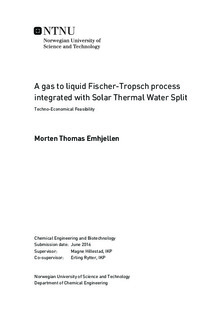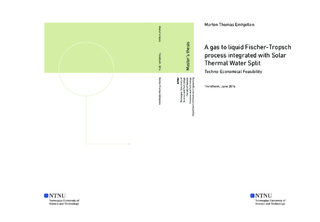| dc.description.abstract | Hydrocarbons are used in many products, and are the primary energy source for current civilizations, mainly as combustible fuel. There is a rapidly growing demand for environmentally friendly and renewable energy sources due to the depletion in fossil energy reserves and the need to reduce greenhouse gas emissions.
The purpose of this work was to further study, optimize and integrate promising process designs for environmentally friendly production of Fischer Tropsch (FT) products, hydrocarbons with a widespread of carbon numbers. Syngas, a mixture of H2 and CO, is the feed for the FT synthesis, and this syngas is derived by using pressure-swing solar thermal water splitting, also known as the pressure swing hercynite cycle. The processes of syngas production from solar thermal water split and the FT synthesis from this syngas are individually studied recently at NTNU.
The primary focus in this thesis was on the process development. Key elements were to explore different design alternatives and optimizing independent variables for the conceptual design and for the heat exchanger network. The conceptual design was developed in Aspen HYSYS®. Different conceptual design choices was explored and investigated. Three different conceptual design configurations were optimized in order to be compared and to decide upon a best case. Three different design configurations of heat exchanger networks (HENs) for the best case conceptual design were proposed. Simulations in Aspen Energy Analyzer® (AEA) were used for developing 60 near optimum HENs for all configurations and to decide upon the best HEN configuration.
The best case utilizes external methane together with the oxygen produced from the solar thermal water splitting to produce additional syngas. 8716kg/h heavy FT product with mass fraction 0.945 of a lump with average carbon number 60 is produced, about 3.25 times higher flowrate than when no external methane is utilized. The overall energy efficiency and carbon efficiency of the final best case is 71.07% and 99.95%, respectively. Finally, a project evaluation was performed and the economic lifetime of the plant was set to 20years, operating 334days a year, 8 hours a day, in South Africa.
The fixed capital investment for the entire plants is MM US$ 269.12, and with the total annual manufacturing cost of MM US$ 31.1, the average sale price of the total FT product has to be US$ 1.89/kg, in order to break even. This sale price is in between the average sale price for FT wax and the sale price of the most valuable FT wax. Several factors, such as the incentives for environmentally friendly production, have not been accounted for when arriving at this number. The debate about green house gas emissions is creating continuously increasing incentives for environmentally friendly production, which indicates a potentially bright future for the plant proposed in this thesis. | |

